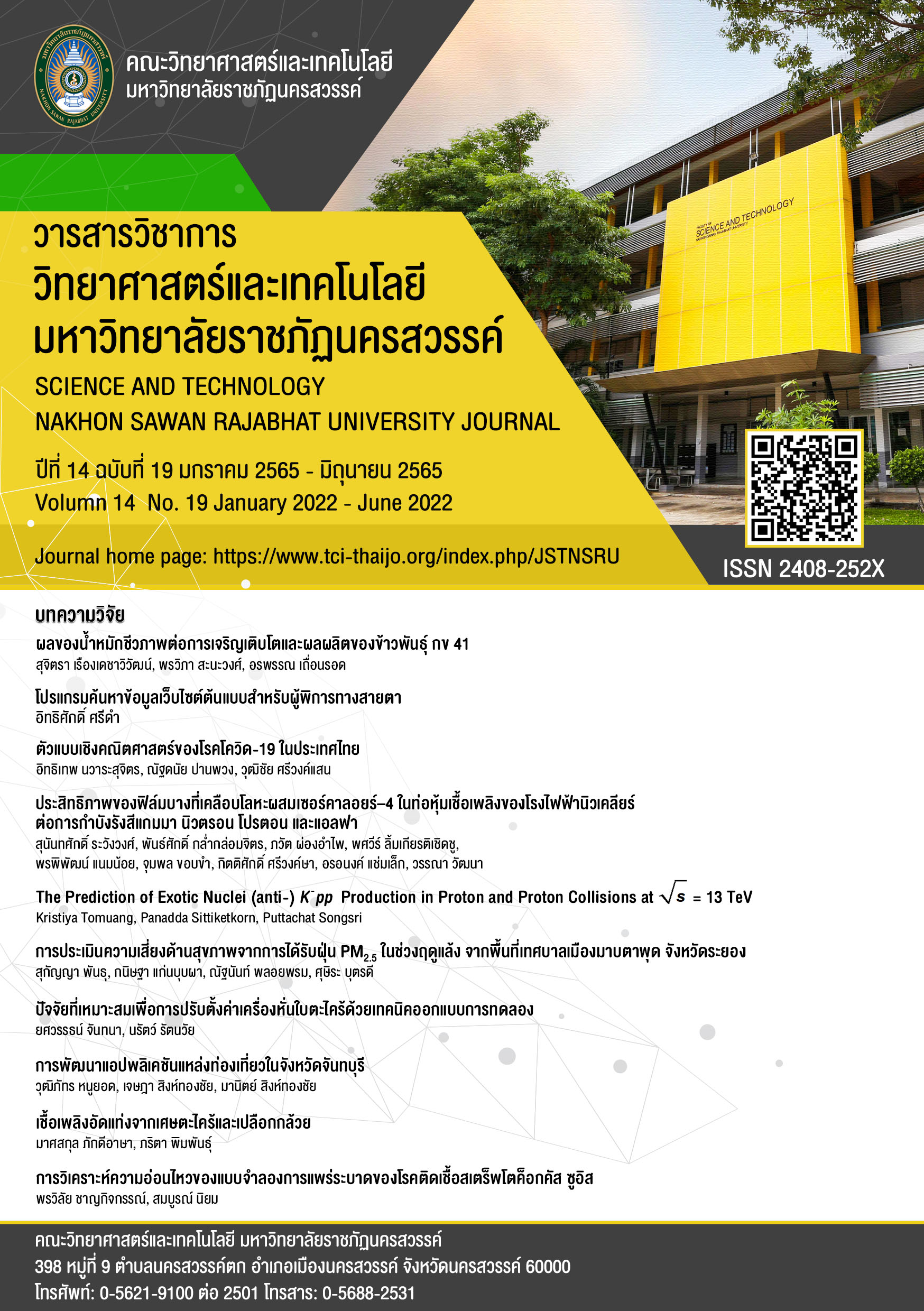การประเมินความเสี่ยงด้านสุขภาพจากการได้รับฝุ่น PM2.5 ในช่วงฤดูแล้ง จากพื้นที่เทศบาลเมืองมาบตาพุด จังหวัดระยอง
Main Article Content
Abstract
ฝุ่นละเอียดหรือฝุ่น PM2.5 เป็นสารมลพิษทางอากาศที่มีผลต่อปัญหาสุขภาพของมนุษย์ ซึ่งส่งผลกระทบต่อระบบทางเดินหายใจและอัตราการเสียชีวิต การวิจัยนี้มีวัตถุประสงค์เพื่อศึกษาความเข้มข้นของฝุ่น PM2.5 ที่ปลดปล่อยมาจากพื้นที่เทศบาลเมืองมาบตาพุด จังหวัดระยอง และนำมาประเมินความเสี่ยงต่อสุขภาพของมนุษย์ในช่วงฤดูแล้ง โดยตัวอย่างฝุ่น PM2.5 สามารถเก็บบนกระดาษกรองใยหิน ด้วยเครื่องเก็บตัวอย่างฝุ่นละอองแบบปริมาตรต่ำ พบว่า มีค่าความเข้มข้นของฝุ่น PM2.5 มีค่าอยู่ในช่วง 3.9-136.0 µg/m3 และมีค่าเฉลี่ย 44.0±28.4 µg/m3 นอกจากนี้ เมื่อทำการประเมินความเสี่ยงต่อสุขภาพด้วยการคำนวณจากค่าสัดส่วนความเสี่ยง (HQ) พบว่า ค่าเฉลี่ย HQ ของฝุ่น PM2.5 ของเด็กในช่วงฤดูแล้งมีค่ามากกว่าผู้ใหญ่และมีค่าเกิน 1.0 ซึ่งแสดงว่า มีความเสี่ยงต่อสุขภาพของมนุษย์ เนื่องจาก เด็กมีความต้องการปริมาณออกซิเจนสูงจึงส่งผลให้อัตราการหายใจต่อน้ำหนักตัวสูง เมื่อทำการประเมินความเสี่ยงการก่อมะเร็งปอดในมนุษย์ (Ric) จากการได้รับฝุ่น PM2.5 อยู่ในช่วง 10-6 ถึง 10-4 ซึ่งหมายความว่า ความเสี่ยงในการก่อมะเร็งอาจจะเกิดขึ้นได้ ผลจาการวิจัยนี้จะสรุปได้ว่า ปริมาณความเข้มข้นของฝุ่น PM2.5 จะไม่ส่งผลกระทบต่อสุขภาพของมนุษย์ อย่างไรก็ตาม ในระยะยาวเด็กมีโอกาสได้รับฝุ่น PM2.5 เข้าสู่ระบบทางเดินหายใจได้มากกว่าผู้ใหญ่ ซึ่งอัตราการหายใจเข้าเฉลี่ยของเด็กจะมีค่าเป็นสามเท่าของผู้ใหญ่
Article Details

This work is licensed under a Creative Commons Attribution-NonCommercial-NoDerivatives 4.0 International License.
References
กรมควบคุมมลพิษ กระทรวงทรัพยากรธรรมชาติและสิ่งแวดล้อม. (2562). แผนปฏิบัติการขับเคลื่อนวาระแห่งชาติ การแก้ไขปัญหามลพิษด้านฝุ่นละออง. https://www.pcd.go.th/strategy/แผนปฏิบัติการขับเคลื่อนวาระแห่งชาติการแก้ไขปัญหามลพิษด้านฝุ่นละออง/
กรมโรงงานอุตสาหกรรม, กระทรวงอุตสาหกรรม. (2564). ข้อมูลสำหรับเจ้าหน้ากรมโรงงานอุตสาหกรรม-จังหวัดระยอง. http://reg.diw.go.th/executive/Amp3.asp?amp=1&prov=21.
กรมอุตุนิยมวิทยา กระทรวงทรัพยากรธรรมชาติและสิ่งแวดล้อม. (2564). Wind Rose. http://www.aws-observation.tmd.go.th/web/aws/aws_windroses.asp
ประกาศคณะกรรมการนโยบายการพัฒนาระเบียงเศรษฐกิจพิเศษภาคตะวันออก. (2561). ราชกิจจานุเบกษา, 135 (ตอนพิเศษ 41 ง). 26.
ประกาศคณะกรรมการสิ่งแวดล้อมแห่งชาติ. (2553). ราชกิจจานุเบกษา, 127 (ตอนพิเศษ 37 ง). 36.
Adamiec, E., & Jarosz-Krzemińska, E. (2019). Human health risk assessment associated with contaminants in the finest fraction of sidewalk dust collected in proximity to trafficked roads. Scientific Reports, 9, 16364. https://doi.org/10.1038/s41598-019-52815-0.
Cao, J., Chow, J.C., Lee, F.S.C., & Watson, J.G. (2013). Evolution of PM2.5 measurements and standards in the U.S. and future perspectives for China. Aerosol and Air Quality Research, 13, 1197-1211. https://doi.org/10.4209/aaqr.2012.11.0302
Chithra, V.S., & Shiva Nagendra, S.M. (2014). Impact of outdoor meteorology on indoor PM10, PM2.5 and PM1 concentrations in a naturally ventilated classroom. Urban Climate, 10, 77-91. https://doi.org/10.1016/j.uclim.2014.10.001
Fang, B., Zhang, L., Zeng, H., Liu, J., Yang, Z., Wang, H., Wang, Q., & Wang, M. (2020). PM2.5-bound polycyclic aromatic hydrocarbons: Sources and health risk during non-heating and heating periods (Tangshan, China). International Journal of Environmental Research and Public Health, 17(2), 483. https://doi.org/10.3390/ijerph17020483.
Greene, N.A. & Morris, V.R. (2006). Assessment of public health risk associated with atmospheric exposure to PM2.5 in Washington, DC, USA. International Journal of Environmental Research and Public Health, 3(1), 86-97. https://doi.org/10.3390/ijerph2006030010
Hamastia, A., Hermawati, E., Marina, R. & Andrian, R. (2019). Estimated analysis on environmental health risk of 2.5 microns particulate matter to urban communities in South Jakarta. Indian Journal of Public Health Research and Development, 10(2), 332-337.
Lelieveld, J., Evans, J. S., Fnais, M., Giannadaki, D., & Pozzer, A. (2015). The contribution of outdoor air pollution sources to premature mortality on a global scale. Nature, 525, 367-371. https://doi.org/10.1038/nature15371
Li, T., Hu, R., Chen, Z., Huang, M., Li, Q.-Y., Huang, S.-X., Zhu, Z. & Zhou, L.-F. (2018). PM2.5: the culprit for chronic lung diseases in China. Chronic Diseases and Translational Medicine, 4(3), 176-186. https://doi.org/10.1016/j.cdtm.2018.07.002
Li, R., Zhou, R. & Zhang, J. (2018). Function of PM2.5 in the pathogenesis of lung cancer and chronic airway inflammatory diseases (Review). Oncology Letters, 15(5), 7506-7514. https://doi.org/10.3892/ol.2018.8355
Liang, B., Li, X.-L., Ma, K., & Liang S.-X. (2019). Pollution characteristics of metal pollutants in PM2.5 and comparison of risk on human health in heating and non-heating seasons in Baoding, China. Ecotoxicology and Environmental Safety, 170(15), 166-170. https://doi.org/10.1016/j.ecoenv.2018.11.075
Liao, C.-M., & Chiang, K.-C. (2006). Probabilistic risk assessment for personal exposure to carcinogenic polycyclic aromatic hydrocarbons in Taiwanese temple. Chemosphere, 63(9), 1610-1619. https://doi.org/10.1016/j.chemosphere.2005.08.051
Liu, Y., Xing, J., Wang, S., Fu, X., & Zheng, H. (2018). Source-specific speciation profiles of PM2.5 for heavy metals and their anthropogenic emissions in China. Environmental Pollution, 239, 544-553. https://doi.org/10.1016/j.envpol.2018.04.047
Miller, M.D., Marty, M.A., Arcus, A., Brown, J., Morry, D. & Sandy, M. (2002). Differences between Children and Adults: implications for Risk Assessment at California EPA. International Journal of Toxicology, 21(5), 403–418. https://doi.org/10.1080/10915810290096630
Mo, Z., Wang, Z., Mao, G., Pan, X., Wu, L., Xu, P., Chen, S., Wang, A., Zhang, Y., Luo, J., Ye, X., Wang, X., Chen, Z., & Lou, X. (2019). Characterization and health risk assessment of PM2.5-bound polycyclic aromatic hydrocarbons in 5 urban cities of Zhejiang province, China. Scientific Reports, 9(1), 7296. https://doi.org/10.1038/s41598-019-43557-0.
Morakinyo, O.M., Adebowals, A.S., Mokgobu, M.I., & Mukhola, M.S. (2017). Health risk of inhalation exposure to sub- 10 µm particulate matter and gaseous pollutants in an urban-industrial area in South Africa: an ecological study. BMJ Global Health, 7(3), 1-9. https://doi.org/10.1136/bmjopen-2016-013941
Narita, D., Kim Oanh, N.T., Sato, K., Huo, M., Permadi, D.A., Ha Chi, N.N., Ratanajaratroj, T., & Pawarmart, I. (2019). Pollution characteristics and policy actions on fine particulate matter in a growing Asian economy: The case of Bangkok metropolitan region. Atmosphere, 10, 227. https://doi.org/10.3390/atmos10050227
Olufemi, A. C., Mji, A., & Mukhola, M.S. (2019). Health risks of exposure to air pollutants among students in schools in the vicinities of coal mines. Energy Exploration and Exploitation, 37(1), 1638-11656. https://doi.org/10.1177/0144598718765489
Prasertsin, S. & Nathapindhu, G. (2020). The temporal pattern of ambient PM2.5 and Health risk assessment in Thailand. Indian Journal of Public Health Research & Development, 11(03), 1096-1100.
Song, C., He, J., Wu, L., Jin, T., Chen, X., Li, R., Ren, P., Zhang, L. & Mao, H. (2017). Health burden attributable to ambient PM2.5 in China. Environmental Pollution, 223, 575-586. https://doi.org/10.1016/j.envpol.2017.01.060
US-EPA National Ambient Air Quality Standards (US-EPA NAAQS). (2015). NAAQS Table. https://www.epa.gov/criteria-air-pollutants/naaqs-table.
US-EPA (United States-Environmental Protection Agency). (2011).Exposure Factors Handbook: 2011 edition; National Center for Environmental Assessment [Internet]. Washington, DC. http://www.epa.gov/ncea/efh.
Zhang, G., Ma, K., Sun, L., Liu, P., & Yue, Y. (2020). Seasonal pollution characteristics, source apportionment and health risk of PM2.5-bound polycyclic aromatic hydrocarbons in an industrial city in northwestern China. Human and Ecological Risk Assessment: An International Journal, 27, 1054-1071. https://doi.org/10.1080/10807039.2020.1799186


